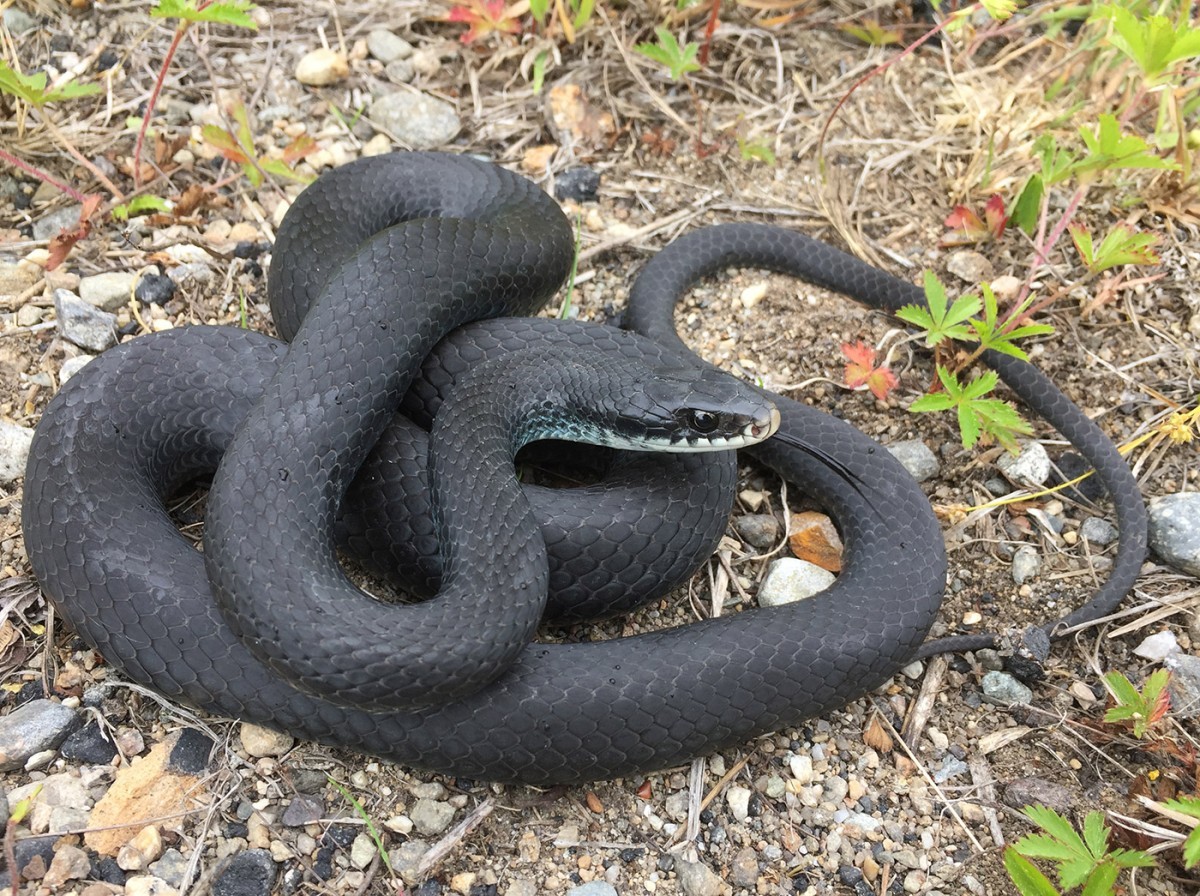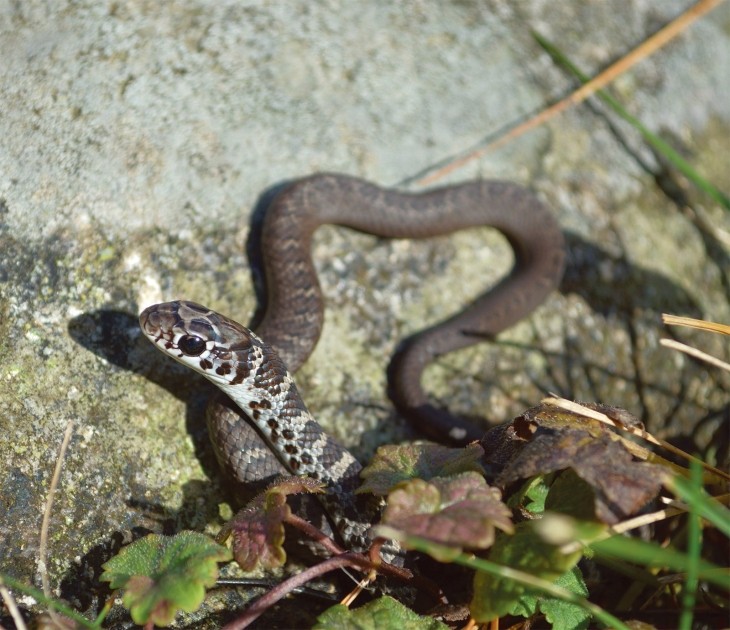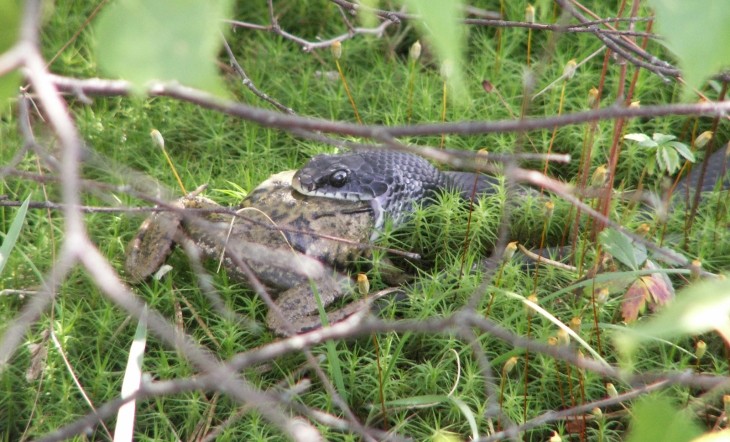HOW ONE OF NEW ENGLAND’S LARGEST SNAKES IS MANAGING TO SURVIVE
Most of us have experienced an unexpected encounter with a snake while doing yard work or taking a walk in a local forest or field. For some, the reaction is fear – more on that later. But for budding naturalists, and those of us who’ve devoted our lives to studying the natural world, an encounter is a source of fascination.
One of the reasons snakes – especially rare ones – are so intriguing is that our region is relatively snake poor. Garter, ring-necked, and brown snakes are considered common, but in all of Vermont, New Hampshire, and Maine, there are only 12 species of snakes. Contrast this with Georgia (approximately equal in size to those three states combined), which hosts 46 species of snakes. Given the fact that snakes are “cold blooded,” and thus depend on outside heat for warmth, it really isn’t that surprising that more snakes call the South home. Most snakes in New England are at or near the northern limit of their geographic range and – like all reptiles and amphibians around here – must search out specific micro-climates to survive. This includes racers.
Another challenge, and one that’s specific to racers, involves their size – adults can be six feet long – and the reaction this size provokes in humans. (At first glance, you might mistake an adult racer for a length of black garden hose – until it moves.) Racers can be curious, defensive, or even aggressive when encountered unexpectedly. They may arch up and elevate their head well above the ground, presumably to get a better look at what is coming. That posture can be especially alarming because it resembles the striking pose of a venomous cobra. (Racers aren’t venomous, though; at worst, a bite will only result in a modest cut from the many small teeth that line their jaws.) When alarmed by an approaching human, racers may also hold their ground by coiling up and drumming their tails against the ground. Such vibrating can be confused with rattling, and startled hikers or gardeners might believe they are being confronted by rattlesnakes. Needless to say, chance encounters with people often don’t end well for the racers.
Back in the 1970s, I regularly encountered racers in southern New Hampshire. Brushy fields and shrublands were among the most likely places to find them. Since that time, the abundance of these habitats has declined substantially, and racers – along with New England cottontails, woodcocks, and a number of shrubland songbirds – have become increasingly scarce throughout the region. The combined effects of shrinking habitats and unnecessary mortalities have reduced populations of racers to levels where they are now considered threatened in Vermont and New Hampshire and endangered in Maine. In response to this decline, biologists at New Hampshire Fish and Game and Maine’s Department of Inland Fisheries and Wildlife are identifying the habitat requirements of racers and where they still occur. Both efforts are revealing many interesting facts about a once poorly understood animal.
RACER BIOLOGY 101
For racers, the year begins in late March or early April when the snakes emerge from their winter dens (hibernacula). They first seek out sunny spots where they can warm up; when they’re sufficiently warm, the hungry snakes then seek out a meal. Racers eat a wide variety of small animals, including slugs, frogs and toads, other snakes, mice, and chipmunks. Their large eyes effectively detect any movement from a potential meal. They can hear, and their long bodies are also sensitive to ground vibrations. Odor is another important source of information for hungry racers: airborne molecules are captured on the snake’s flicking tongue, and after the tongue is retracted, odor is detected by the Jacobson’s (or vomeronasal) organ on the roof of the mouth. A racer can figure out the general direction of the prey animal based on which tine of its forked tongue captures the scent molecules. Once in close proximity to their prey, racers move quickly. They can reach 10 miles per hour, making them among the fastest snakes. In contrast to their scientific name (Coluber constrictor), racers do not constrict their prey the way pythons or boas do. Rather, a racer simply bites its prey, and many small, backward-pointing teeth hold the animal as the racer swallows it.
As the weather warms, males use scent to find females. Maine biologists Derek Yorks and Trevor Persons have found that racers exhibit some distinctly social behaviors, including forming loose groups during the mating season. Although some snakes give birth to live young, female racers lay eggs. The average racer lays 10 to 12 eggs in rotting logs, mammal burrows, sandy banks, or even garden mulch. Hatching occurs in about six weeks, and the emerging young racers look very different from their parents, with dark bands and spots on tan or gray skin. Those pigments are eventually shed and replaced by a uniform, dark skin. Skin shedding, or molting, is a regular event for all snakes. Like those of other reptiles, a snake’s skin has two layers. The inner dermis contains blood vessels, nerve endings, and connective tissue; the outer layer, or epidermis, is a protective sheath that is meant to shield deeper tissues from injury. As a result, the epidermis is subjected to scrapes, cuts, and even bites from potential predators. Shedding does not occur on any predetermined schedule, and injuries may speed up a shedding event as part of the healing process. Shedding begins with the death of the base cells in the epidermis, and these dissolving cells cause the skin to soften and look dull or waxy. At this stage, the skin covering the eyes often has a pale-blue cast. Shedding starts at the lips, and the snake rubs against sticks or rocks in an effort to scrape off the loose skin. If the skin catches on an object, the snake will literally crawl out of its skin, turning it inside out. Biologists use both historic data and recent reports by amateur naturalists to locate existing racer populations. For example, based on a tip from a group of New Hampshire rock climbers, Fish and Game biologists Mike Marchand and Brendan Clifford located a population of 30 racers along a powerline corridor in Goffstown. Once captured, the snakes were measured, weighed, gender recorded, and tagged with microchips. Some of the captured racers were also equipped with radio transmitters so the biologists could determine where they spent their time and how far they moved. Unlike the radio collars used to track bobcats or moose, transmitters for snakes have to be implanted in the animals’ bodies by cooperating veterinarians. So far, radio-tagged racers have shown a strong preference for open, scrubby habitats with only scattered trees. Such habitats are rare in northern New England, where closed-canopy forests predominate. In Maine, racer strongholds include the sandy barrens of Wells, Kennebunk, and Sanford. Strongholds in New Hampshire include flood-control lands and powerline corridors in Hillsborough and Merrimack counties. Additionally, racers may be encountered at sand and gravel mines across the state.
Radio-tagged racers occupied home ranges as large as 1.5 square miles, and they’ve been recorded exploring well beyond their usual haunts. In Maine, for instance, one female racer traveled more than half a mile in a single day. That’s a remarkable distance for a snake and has important survival implications if snakes end up crossing roads during these long-distance jaunts. Road-killed racers are not uncommon, but surprisingly, only one radio-tagged snake in Maine or New Hampshire has been killed while crossing a road – probably because the tagged snakes occupy large blocks of habitat with few roads.
HOLING UP FOR THE WINTER
As summer passes and cool weather waxes in October and early November, racers seek out belowground refuges to avoid the extremes of winter. A hibernaculum must have at least some space below the frost line. Often, snakes rely on vacant burrows dug by other animals, especially chipmunks. These burrows can be occupied by one or as many as 10 snakes. Unfortunately, chipmunk burrows are susceptible to collapse when heavy equipment, like a bulldozer or skidder, passes over them. Brendan Clifford rescued several racers in New Hampshire after detecting one of his radio-tagged snakes in a collapsed den. Rocky outcrops, on the other hand, provide more reliable chambers. Such dens may be large enough to provide winter security for many snakes, often of different species. In the 1940s, Donald Carle, a science professor in New Hampshire, reported finding 112 racers near a winter den location in Keene. This observation demonstrates the importance of quality dens, and perhaps their scarcity. Concern over den availability prompted Vermont Fish and Wildlife biologist Doug Blodgett to team up with the Vermont Agency of Transportation to construct an artificial winter den near a rest area on Interstate 91, where racers were known to live. Using construction debris and large rocks, they created the features of a rocky outcrop. So far, other snakes have used the site, but racers haven’t shown up.
Once in a den, racers enter a state of dormancy called brumation, where they remain awake but become lethargic. This differs from hibernation, where animals like chipmunks and woodchucks experience changes to their blood chemistry, have substantial drops in heart rate and breathing, and are very slow to rouse. On warm days in late fall or early spring, snakes will leave the den briefly to bask in the sunshine. Generally, however, racers remain in their winter dens when daytime temperatures are below 60 degrees. As with most animals that are dormant during winter, survival is highest among snakes that have large energy reserves upon den entry because they do not eat until spring.
CHALLENGES TO RACER CONSERVATION
The illegal pet trade is not an issue for black racers because the snakes present challenges in captivity: they do not like to be handled, they require very large cages, and they are difficult to feed. But some of the obstacles facing other threatened wildlife populations are affecting the security of racer populations in northern New England. Adequate habitat is the most obvious limitation. Although some of the sites currently occupied by racers are protected and managed by land trusts, governmental agencies, or utility companies that maintain powerline corridors, there are many other demands for the flat, dry land that racers prefer.
In the late 1990s, graduate student Victoria Kjoss and I studied a population of racers on a large tract of idle farmland in southeastern New Hampshire. Since then, that land has been incrementally subdivided and is now a cluster of more than 100 single-family homes. In addition, large-scale solar arrays are becoming an important alternative to fossil-fuel power generation, and developers of “solar farms” gravitate toward the open, sunny, unoccupied sites that the snakes look for. In New Hampshire, for example, a municipal solar farm was constructed on a 12-acre portion of an abandoned sand and gravel mine in the town of Lee. And in Maine, a large commercial solar farm is planned for 150 acres of racer habitat in Sanford. Competing land uses for wildlife habitat is not a new issue, and it is difficult to argue against the development of a clean energy source. The challenge, as always, is to find some balance.
In New Hampshire, a group of racers was relocated from a retail development in Merrimack to conserved land in Hopkinton. Unfortunately, the translocated snakes did not survive the move, possibly as a consequence of their not capturing sufficient prey or failing to locate an adequate winter den in their new environment. It is likely that there will be more attempts to translocate racers because of the demands of expanding human settlement. Let’s hope that they will be successful.
A new threat has emerged that has increased unease among biologists working to maintain current populations of racers. In 2006, Mike Marchand discovered that an isolated New Hampshire population of timber rattlesnakes had become infected with a fungus. Initially, the fungus seemed to be no more than a nuisance because a healthy snake is able to avoid any serious symptoms by simply shedding its infected skin. But if the fungus persists, it can damage tissue around the mouth and eyes, making it difficult for an infected snake to forage. Over time, the fungus can penetrate the body cavity of a weakened snake, causing damage to the lungs, liver, and kidneys. Such a severe infection usually results in death. Since its initial discovery, snake fungal disease (SFD) has been detected in other snakes – including black racers. There is some speculation that the fungus may be spreading among snakes in communal dens and that warmer, wetter weather may be spurring on the fungus. Currently, there is no clear way to limit the spread of SFD. Luckily, racers in Maine have not been infected yet.
OUR ATTITUDES TOWARD SNAKES
Perhaps the greatest challenge to snake conservation is public support. Although there are advocates for conservation, many humans have a viscerally negative attitude toward snakes. There’s been some interesting research into whether a fear of snakes (ophidiophobia) is innate or learned. In one study, juvenile monkeys were cautious when encountering strange or novel objects. That caution subsequently developed into a fear response if the female parent reinforced the youngster’s response by expressing alarm toward the object. This pattern suggests some element of innate behavior but also shows the importance of experience or learning. More recently, six-month-old human infants were presented with sets of pictures of either spiders and flowers or snakes and fish. Researchers monitored the infants’ pupillary responses and found that they reacted with increased pupil dilation to the pictures of spiders and snakes compared to the pictures of flowers and fish. These results suggest that humans may indeed have evolved to acquire specific fears of ancestral threats like snakes. But that fear may also be affected by subsequent learning.
Conservationists are challenged to counter the fear response by providing a more complete understanding of the ecological role of snakes. It is unlikely that we’ll be able to eliminate completely the negative reputation that snakes have – there are just too many parables and stories passed on to children where a snake is the villain. But there are some examples where education about, and positive representations of, snakes are making a difference. Citizens of Ohio, for instance, recently selected black racers as their state reptile. With that designation, educators and conservationists in the state have an opportunity to accurately inform the public about the important ecological role played by snakes. Perhaps we can do the same in New England.










Discussion *